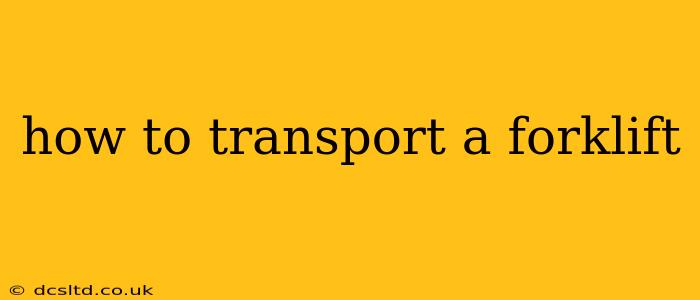Transporting a forklift, whether a small hand pallet jack or a large industrial model, requires careful planning and execution to ensure safety and compliance with regulations. This guide covers various methods, considerations, and legal aspects to help you move your forklift safely and efficiently.
What's the Best Way to Transport a Forklift?
The optimal method for transporting a forklift depends on several factors, including:
- Distance: Short distances might allow for driving the forklift itself, while longer journeys necessitate specialized transport.
- Forklift Size and Weight: Larger and heavier forklifts require more robust transport solutions.
- Accessibility: Consider the availability of loading ramps, suitable trailers, and road conditions.
- Budget: Different transport methods vary significantly in cost.
Common methods include:
- Driving the Forklift (Short Distances): This is the simplest option for short distances on suitable roads. Ensure the operator is licensed and the forklift is roadworthy (with appropriate lights and safety features).
- Lowboy Trailer: Ideal for larger forklifts, a lowboy trailer provides a low-profile platform for secure transportation. Forklifts are often loaded using ramps or a loading dock.
- Roll-Off Trailer: These trailers allow the forklift to be driven onto the trailer and then secured for transport.
- Flatbed Trailer: Similar to a lowboy but often requires additional securing methods.
- Heavy-Haul Transport: For extremely large or heavy forklifts, specialized heavy-haul transport is necessary. This usually involves lowboy trailers with specialized permits and drivers.
How Do I Secure a Forklift for Transport?
Securing a forklift during transport is crucial for preventing accidents and damage. The specific methods depend on the transport method but generally include:
- Wheel Chocks: Prevent movement during loading and unloading.
- Straps and Chains: Secure the forklift to the trailer, ensuring they're properly tensioned and rated for the forklift's weight. Never rely on just one type of securing method; use a combination for maximum safety.
- Parking Brake: Always engage the forklift's parking brake.
- Forklift Tilt Mechanism: If possible, lower the forks to the ground and lock them in place.
What Permits or Licenses Do I Need to Transport a Forklift?
Legal requirements vary by location but generally include:
- Driver's License: The driver must possess a valid driver's license appropriate for the vehicle used for transportation.
- Special Permits: For overweight or oversized forklifts, special permits may be required from local transportation authorities. These permits often specify routes and speed limits.
- Insurance: Ensure you have adequate insurance coverage to cover potential damage or accidents during transport.
Note: Always check with your local Department of Transportation or relevant authorities for specific legal requirements in your area.
What are the Safety Precautions When Transporting a Forklift?
Safety is paramount during forklift transport. Consider these precautions:
- Pre-Trip Inspection: Before transport, thoroughly inspect the forklift and trailer for any potential issues.
- Proper Securing: Double-check that the forklift is securely fastened to the trailer using appropriate straps, chains, and wheel chocks.
- Roadworthiness: Ensure the transport vehicle is in good working order and meets all safety standards.
- Route Planning: Plan the route carefully, avoiding low bridges, sharp turns, and narrow roads.
- Weather Conditions: Monitor weather forecasts and avoid transport during severe weather conditions.
- Professional Help: For complex or large-scale transport, consider hiring professional heavy-haul transport services.
Can I Transport a Forklift Myself?
You can transport a forklift yourself if you meet certain criteria:
- Short Distance: The distance is relatively short and manageable.
- Appropriate Equipment: You have access to a suitable trailer and securing equipment.
- Licensing and Insurance: You possess the necessary driver's license, permits, and insurance.
- Experience and Expertise: You have the skills and experience to safely load, secure, and transport the forklift.
How Much Does it Cost to Transport a Forklift?
The cost of transporting a forklift varies greatly depending on distance, forklift size, type of transport, and any special permits required. Get quotes from multiple transport companies to compare prices and services.
What are the Different Types of Forklift Trailers?
Several types of trailers are suitable for transporting forklifts, including lowboy trailers, flatbed trailers, and roll-off trailers, each with its own advantages and disadvantages in terms of loading, securing, and cost-effectiveness. The choice depends on the forklift's size and weight.
This comprehensive guide provides essential information about transporting a forklift. Always prioritize safety and ensure compliance with all applicable laws and regulations. Remember to consult with professionals for complex or large-scale transportation needs.
